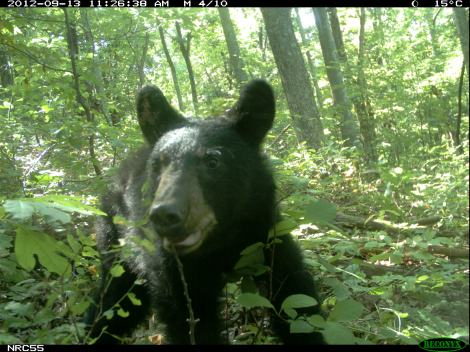Black bears (Ursus americanus) are fascinating animals, and future posts will cover their complex individual personalities and their amazing biology (who else gives birth while in torpor over the winter!?). For this first bear post we will simply cover bear body language, a fascinating subject in itself and something that is good to know for anyone who spends time in bear country.
In most areas, black bears have flexible territories that shift throughout the year to accommodate different food resources and mating needs. To maintain these shifting and usually overlapping territories, black bears have developed both complex scent marking and body language communication behaviors.
We will cover scent marking at more detail in later posts, but bears often use certain large trees to rub and scent mark, and will also pee constantly as they walk along to mark their presence. Bear encounters range from playful wrestling between siblings to deadly fights between dispersing sub adults and adults, but for the most part bears avoid each other. Bears will often use scent marks to avoid each other, but if two bears meet they will use body language and vocalizations to communicate their intentions.
One of the most iconic bear body language displays is a bear standing on its hind legs. Although this has been popularized in some movies as a threat posture, bears that are standing on their hind legs are always curious about something and trying to get a better view. They may be curious and feel threatened or they may just be curious. If you see a bear standing up with its ears facing forward, than the bear is just trying to get a better look at you and figure out what you are. Bears will also stand with arms open and their ears out to their sides in an invitation to play, but humans are unlikely to see this behavior unless you are watching a family group or have a very special relationship with a bear!
A bear that is afraid and/or trying to scare off another bear (or you!) will often emit explosive woofs and huffs, and may rear up and slap the ground with their front paws. Although can be a terrifying display, it is really a sign that the bear is scared of you or something else. Females with cubs may perform this display while their cubs go up a tree or go behind their mother, and that is a good time to back slowly away and remove yourself as a threat.
If a bear is more aggressive or is escalating their threat level, they will lay their ears back flat on their head, hold their head sideways to the threat, and pop their jaws together, often while drooling. The jaw pop is surprisingly loud and is done with enough force that it seems like it would damage the bears own teeth. This is a sign that the bear is feeling threatened enough to attack, and it is a good idea to remove yourself from the situation (without running!).
Bears can also charge during either threat stage. Almost all charges are bluff charges, but this is seldom a comforting thought when several hundred pounds of bear is charging you at 30 mph!
To find out more about bears look for future posts and check out the links below:
Sources
Elbroch, Mark and Kurt Rinehart. Behavior of North American Mammals. New York: Houghton Mifflin, 2011. Print.
Lariviere, S. 2001. Ursus americanus. Mammalian Species 647:1-11.



Pingback: Eastern Gray Squirrel Territoriality |·
So if we feel threatened, we should walk away…backwards? (risking tripping) Or is it OK to turn your back on the bear?
If a bear is approaching you stand your ground and make noise and wave your arms. The Alaskan standard is to yell “Hey bear!” Do not turn your back or run. This post was to also give you an idea of body language so that you can assess the threat level. If a bear is approaching you with its ears forward and “whoofing” it is trying to figure out what you are, and waving your hands and letting it know you are a person will help the bear move on. If the bear is being more aggressive you can look around and make sure you have not unintentionally separated a mother from her cubs, in which case you would move away to allow them to reunite. In any other situation don’t run or turn your back on the bear. There is no a need to walk backwards, standing your ground works better. If the bear is a campground bear that is habituated to people than you should aggressively drive it away without getting close to it (make lots of noise and throw things at it), but if it comes very close to your tent/pack/picnic I would back off unless you have bear spray.
Want to order something but don’t use paypal.
Hi, we don’t sell anything at the moment! Thanks for your comment.